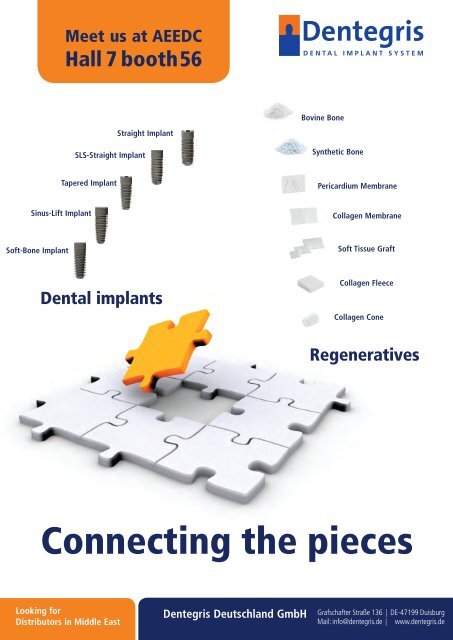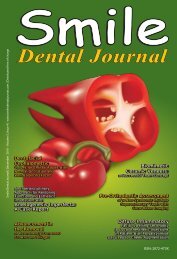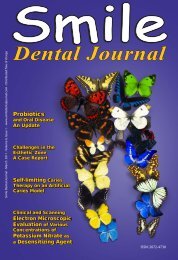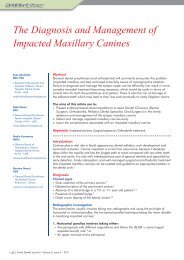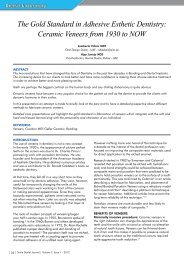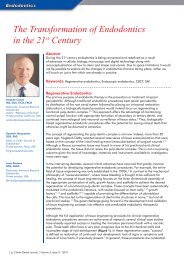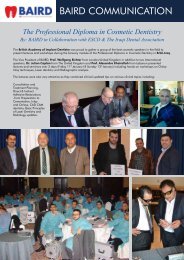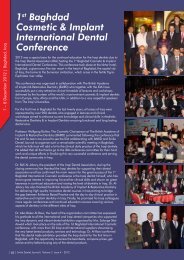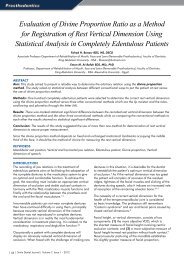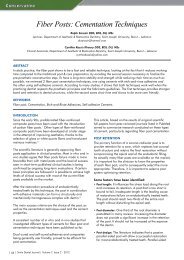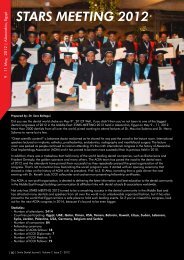Download e-copy - Smile Dental Journal
Download e-copy - Smile Dental Journal
Download e-copy - Smile Dental Journal
Create successful ePaper yourself
Turn your PDF publications into a flip-book with our unique Google optimized e-Paper software.
TOOLS TO KEEP SMILING<br />
No less than ...<br />
...4 launches !<br />
Mechanical scouting sequence<br />
10/.02<br />
www.d-race.ch<br />
15/.02<br />
Desobturation made easy<br />
Discover the other novelties on<br />
www.fkg.ch<br />
20/.02<br />
• The best results are achieved if there is good contact<br />
between the lateral incisor and first premolar. 1,4<br />
• It is indicated in patients willing to undergo<br />
orthodontic treatment to substitute the first premolar<br />
for the canine. 1,4<br />
• The possible risk of damaging the roots of adjacent<br />
teeth during the surgical removal of the impacted<br />
canine should be assessed and discussed with the<br />
patient. 1<br />
Auto-transplantation<br />
• This treatment option should be considered<br />
if the patient is unwilling to wear orthodontic<br />
appliances. 1,4<br />
• Transplantation is indicated where interceptive<br />
extraction of the deciduous canine has failed or<br />
is unsuitable, and exposure and alignment of the<br />
impacted canine is not possible. 1,4<br />
• There should be adequate space available for the<br />
canine and sufficient alveolar bone to accept the<br />
transplanted tooth. 1,4<br />
• The prognosis should be good if the canine to be<br />
transplanted shows no evidence of ankylosis. 1<br />
• The best results are achieved if the impacted canine<br />
can be removed atraumatically. 1,4<br />
• Depending on the stage of root formation (more<br />
than 3/4 of the root formed) the transplanted canine<br />
may require root canal therapy to be commenced<br />
within ten days following transplantation. 1<br />
No treatment and continuous monitoring<br />
• The patient does not want treatment or is happy with<br />
their dental appearance. 1,4<br />
• There should be no evidence of root resorption of<br />
adjacent teeth or other pathology. 1<br />
• There should be good contact between the lateral<br />
incisor and first premolar or the deciduous canine<br />
should have a good prognosis. 1,4<br />
• Severely displaced palatally impacted canines with no<br />
evidence of pathology may be left in-situ, particularly if<br />
the canine is remote from the dentition. 1<br />
• Impacted canines left in-situ necessitate<br />
radiographic monitoring to check for cystic changes<br />
or root resorption. 1,4<br />
• Regular review to ensure that the impacted canine<br />
does not pose any risk to the adjacent structures. 1,4<br />
References<br />
1. Management of the palatally ectopic maxillary canine, Husain<br />
J. et al., Publication of the Royal College of Surgeons, Faculty of<br />
<strong>Dental</strong> Surgery, online publication, updated March 2010.<br />
2. A review of the diagnosis and management of impacted<br />
maxillary canines, Bedoya M. and Park J., The <strong>Journal</strong> of the<br />
American <strong>Dental</strong> association (JADA). 2009;140:12:1485-93.<br />
3. Managing the maxillary canine: 1. Diagnosis, localization<br />
and interceptive treatment, McIntyre G., Orthodontic Update,<br />
January 2008;1:7-15.<br />
4. Clinical Practice Guidelines, The management of the palatally<br />
ectopic canine, Ministry of Health Malaysia, September 2004.<br />
• Crêt-du-Locle 4 • CH-2304 La Chaux-de-Fonds • Switzerland •<br />
• Tél.: +41 (0)32 924 22 44 • Fax: +41 (0)32 924 22 55 • info@fkg.ch • www.fkg.ch •<br />
| 42 | <strong>Smile</strong> <strong>Dental</strong> <strong>Journal</strong> | Volume 6, Issue 4 - 2011


